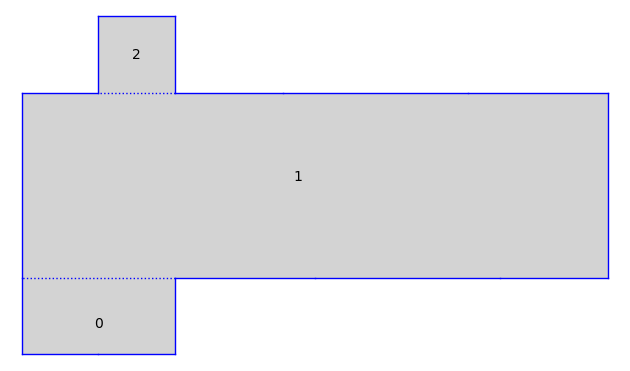Exploring Orbit Closures¶
We demonstrate how to use sage-flatsurf to compute the GL(2,R)-orbit closure
of a surface. This example was interesting to P. Apisa and A. Wright.
Parts of this rely on the C++ library libflatsurf. Please consult our installation guide if it is not available on your system yet.
Building the Surface and Orbit Closure¶
We consider the following half-translation surface
+---5---+
| |
4 4
| |
+ +---5---+---6---+---7---+---8---+
| |
3 3
| |
+ +---8---+---7---+---6---+
| |
2 2
| |
+---1---+---1---+
It belongs to \(Q_3(10, -1^2)\).
from flatsurf import Polygon, MutableOrientedSimilaritySurface
def apisa_wright_surface(h24, h3, l15, l6, l7, l8):
K = Sequence([h24, h3, l15, l6, l7, l8]).universe().fraction_field()
v24 = vector(K, (0, h24))
v3 = vector(K, (0, h3))
v15 = vector(K, (l15, 0))
v6 = vector(K, (l6, 0))
v7 = vector(K, (l7, 0))
v8 = vector(K, (l8, 0))
S = MutableOrientedSimilaritySurface(K)
S.add_polygon(Polygon(edges=[v15, v15, v24, -2 * v15, -v24]))
S.add_polygon(
Polygon(edges=[2 * v15, v8, v7, v6, v3, -v8, -v7, -v6, -v15, -v15, -v3])
)
S.add_polygon(Polygon(edges=[v15, v24, -v15, -v24], base_ring=K))
S.glue((0, 0), (0, 1))
S.glue((0, 2), (0, 4))
S.glue((0, 3), (1, 0))
S.glue((1, 1), (1, 5))
S.glue((1, 2), (1, 6))
S.glue((1, 3), (1, 7))
S.glue((1, 4), (1, 10))
S.glue((1, 8), (2, 2))
S.glue((1, 9), (2, 0))
S.glue((2, 1), (2, 3))
S.set_immutable()
return S
We use some simple parameters:
K = QuadraticField(2)
a = K.gen()
S = apisa_wright_surface(1, 1 + a, 1, a, 1 + a, 2 * a - 1)
S.plot(edge_labels=False)

S
Half-Translation Surface in Q_3(10, -1^2) built from a square and 2 rectangles
Now build the canonical double cover and orbit closure:
U = S.minimal_cover("translation")
U.stratum()
H_6(5^2, 0^2)
Now build the orbit closure. The snippet below explores saddle connection up to
length 16 looking for cylinders. Each decomposition into cylinders and minimal
components provides a new tangent direction in the GL(2,R)-orbit closure of
the surface via A. Wright’s cylinder deformation.
from flatsurf import GL2ROrbitClosure # optional: pyflatsurf
O = GL2ROrbitClosure(U) # optional: pyflatsurf
O.dimension() # optional: pyflatsurf
2
The above dimension is just the current dimension. At initialization it only
consists of the GL(2,R)-direction.
old_dim = O.dimension() # optional: pyflatsurf
for i, dec in enumerate(O.decompositions(16, bfs=True)): # optional: pyflatsurf
O.update_tangent_space_from_flow_decomposition(dec)
new_dim = O.dimension()
if old_dim != new_dim:
holonomies = [cyl.circumferenceHolonomy() for cyl in dec.cylinders()]
# .area() as reported by liblatsurf is actually twice the area
areas = [cyl.area() / 2 for cyl in dec.cylinders()]
moduli = [
(v.x() * v.x() + v.y() * v.y()) / area for v, area in zip(holonomies, areas)
]
u = dec.vertical().vertical()
print("saddle connection number", i)
print("holonomy :", u)
print("length :", RDF(u.x() * u.x() + u.y() * u.y()).sqrt())
print("num cylinders :", len(dec.cylinders()))
print("num minimal comps. :", len(dec.minimalComponents()))
print("current dimension :", new_dim)
print("cyls. holonomies :", holonomies)
print("cyls. moduli :", moduli)
if new_dim == 7:
break
old_dim = new_dim
print("-" * 30)
saddle connection number 0
holonomy : (-1, 0)
length : 1.0
num cylinders : 6
num minimal comps. : 0
current dimension : 3
cyls. holonomies : [(-1, 0), ((-4*a-2 ~ -7.6568542), 0), (-1, 0), (-2, 0), ((-4*a-2 ~ -7.6568542), 0), (-2, 0)]
cyls. moduli : [1, (-2*a+6 ~ 3.1715729), 1, 2, (-2*a+6 ~ 3.1715729), 2]
------------------------------
saddle connection number 1
holonomy : (0, -1)
length : 1.0
num cylinders : 2
num minimal comps. : 2
current dimension : 4
cyls. holonomies : [(0, (-2*a-5 ~ -7.8284271)), (0, (-2*a-5 ~ -7.8284271))]
cyls. moduli : [(2*a+5 ~ 7.8284271), (2*a+5 ~ 7.8284271)]
------------------------------
saddle connection number 2
holonomy : (-1, -1)
length : 1.4142135623730951
num cylinders : 2
num minimal comps. : 2
current dimension : 5
cyls. holonomies : [((-3*a-3 ~ -7.2426407), (-3*a-3 ~ -7.2426407)), ((-3*a-3 ~ -7.2426407), (-3*a-3 ~ -7.2426407))]
cyls. moduli : [(12*a+18 ~ 34.970563), (12*a+18 ~ 34.970563)]
------------------------------
saddle connection number 6
holonomy : ((a-1 ~ 0.41421356), (-a-1 ~ -2.4142136))
length : 2.449489742783178
num cylinders : 2
num minimal comps. : 1
current dimension : 6
cyls. holonomies : [((a-1 ~ 0.41421356), (-a-1 ~ -2.4142136)), ((a-1 ~ 0.41421356), (-a-1 ~ -2.4142136))]
cyls. moduli : [(-12*a+18 ~ 1.0294373), (-12*a+18 ~ 1.0294373)]
------------------------------
saddle connection number 412
holonomy : ((6*a-1 ~ 7.4852814), (-5*a-7 ~ -14.071068))
length : 15.938142508386589
num cylinders : 2
num minimal comps. : 1
current dimension : 7
cyls. holonomies : [((284*a ~ 401.63665), (-268*a-376 ~ -755.00923)), ((284*a ~ 401.63665), (-268*a-376 ~ -755.00923))]
cyls. moduli : [(47880*a+67904 ~ 135616.55), (47880*a+67904 ~ 135616.55)]